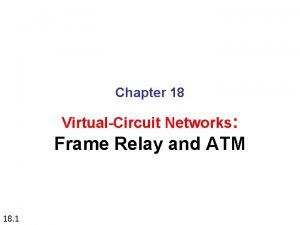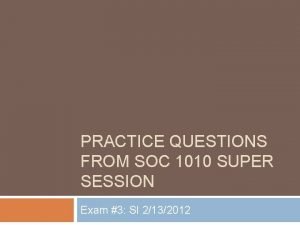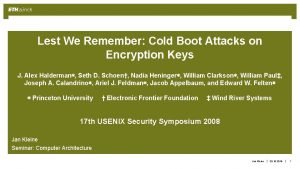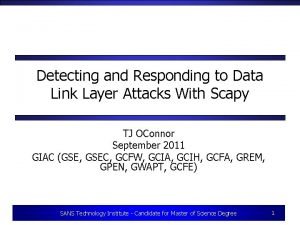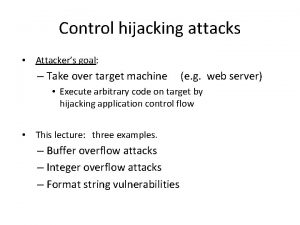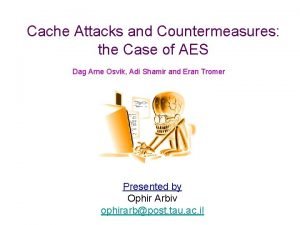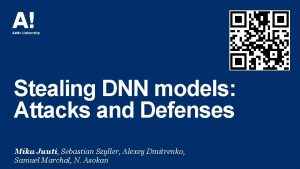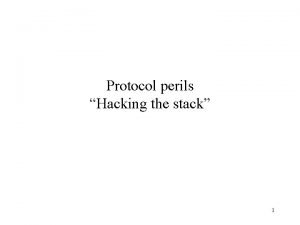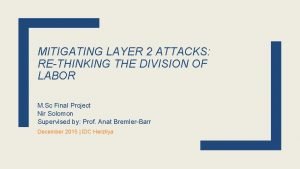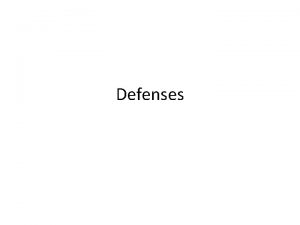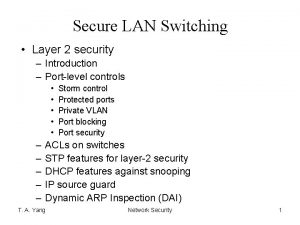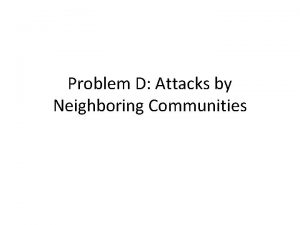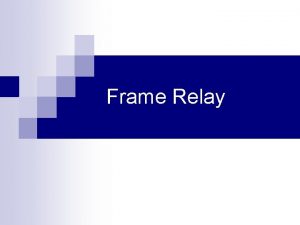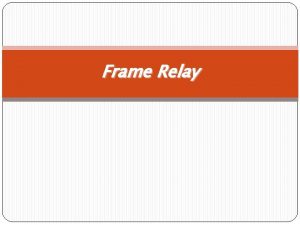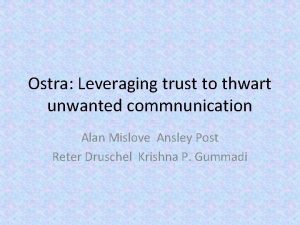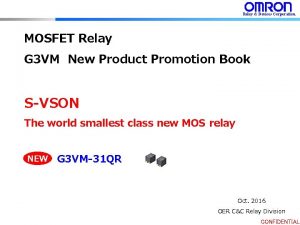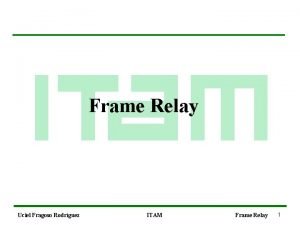A LowCost Method to Thwart Relay Attacks in





![Currently Proposed Defense Methods • Distance Bounding [BC 93, HK 05] [BC 93] Stefan Currently Proposed Defense Methods • Distance Bounding [BC 93, HK 05] [BC 93] Stefan](https://slidetodoc.com/presentation_image/4e571ae833988f22b0e684f3dd5f5ef8/image-6.jpg)



























![References [BC 93] Stefan Brands and David Chaum. Distance-bounding protocols. In Theory and Application References [BC 93] Stefan Brands and David Chaum. Distance-bounding protocols. In Theory and Application](https://slidetodoc.com/presentation_image/4e571ae833988f22b0e684f3dd5f5ef8/image-34.jpg)
- Slides: 34

A Low-Cost Method to Thwart Relay Attacks in Wireless Sensor Networks Reza Shokri Tutors: Panos Papadimitratos, Marcin Poturalski 29 January 2008

Agenda • • • Neighbor Discovery and Relay Attacks Currently Proposed Defense Methods Our System Model A Low-Cost Method to Thwart Relay Attacks Analysis and Simulation Results Conclusion 2

Neighbor Discovery • Neighbor Discovery is the Building Block of Multi-Hop Communication in WSN. • Security Requirements – Authenticity (Authenticating the neighbors) – Availability (Discovering all neighbors) – Correctness (Verifying the neighborhood relation) • Threats – Impersonation Attacks – Denial of Service (e. g. Jamming Attack) – Relay Attack 3

Relay Attack • Relaying messages between two nodes in a way that: nodes believe they are neighbors while they are not. • Placing a Relay Point in vicinity of BS, the attacker attracts nodes to route their packets through the Relay Channel. • Having control over the channel, he can perpetrate powerful external attack on Fake Links. A 1 4

Agenda • • • Neighbor Discovery and Relay Attacks Currently Proposed Defense Methods Our System Model A Low-Cost Method to Thwart Relay Attacks Analysis and Simulation Results Conclusion 5
![Currently Proposed Defense Methods Distance Bounding BC 93 HK 05 BC 93 Stefan Currently Proposed Defense Methods • Distance Bounding [BC 93, HK 05] [BC 93] Stefan](https://slidetodoc.com/presentation_image/4e571ae833988f22b0e684f3dd5f5ef8/image-6.jpg)
Currently Proposed Defense Methods • Distance Bounding [BC 93, HK 05] [BC 93] Stefan Brands and David Chaum. Distance-bounding protocols, 1993. • Location-based [HPJ 03, SRB 01] [HPJ 03] Y. -C. Hu, A. Perrig, and D. B. Johnson. Packet leashes: a defense against wormhole attacks in wireless networks, 2003. • Using Directional Antenna [HE 04] Lingxuan Hu and David Evans. Using directional antennas to prevent wormhole attacks, 2004. • Connectivity-based [BDV 05, MGD 07] [BDV 05] Levente Buttyán, László Dóra, and István Vajda. Statistical wormhole detection in sensor networks, 2005. 6

Observations • These solutions are – Impractical in wireless sensor networks because they require sophisticated hardware or trustworthy external information – Not resilient against strong adversaries. 7

Agenda • • • Neighbor Discovery and Relay Attacks Currently Proposed Defense Methods Our System Model A Low-Cost Method to Thwart Relay Attacks Analysis and Simulation Results Conclusion 8

IEEE 802. 15. 4 Channel Model • The IEEE 802. 15. 4 standard addresses a simple, low-cost communication network that allows a wireless connectivity between devices with a limited power. • Signal propagation of Mica. Z, IEEE 802. 15. 4 compliant, mote modules (Equipped with CC 2420 RF transceivers on 2. 4 GHz Frequency band): Received Signal Power (d. Bm) at Distance d (m) Transmission Signal Power (d. Bm) Path Loss 1 (d. Bm) at Distance d (m) 1. Path loss (or path attenuation) is the reduction in power density (attenuation) of an electromagnetic wave as it propagates through space. 9

IEEE 802. 15. 4 Channel Model Received Signal Strength via Distance (on Mica. Z) 10

Network Model • A static wireless sensor network, composed of tiny motes uniformly distributed in the field. • Nodes are able to transmit with different power levels and can measure the received signal strength. • Inspired from the channel characteristics, neighbors have following properties: – – Channel Symmetry Bidirectional Connection Transitivity Signal Attenuation Polygon Distance Plausibility 11

Channel Symmetry • For any pair of neighbors, the path loss is equivalent in both directions (because it is dependent to distance). • In practice there is a Symmetry Error. • The difference between RSS in two directions should be less than Symmetry Error. 12

Bidirectional Connection Transitivity Suspicious Case • Noise Floor at s < Received Signal Power from v • Received Signal Power from v < Received Signal Power from u • If s can not hear u, maybe there is a selective relay attack in between 13

Signal Attenuation • Clearly, based on the path loss model: d 0: The reference distance (usually 1 m in low-power communication), is chosen to be at a distance at which the propagation can be considered to be close enough to the transmitter such that multi-path and diffraction are negligible and the link is approximately that of free-space. 14

Polygon Distance Plausibility • Distance between connected nodes should match to a polygon on a plane. • Error in distance estimation will be considered. 15

We use currently proposed Security Association (SA) establishment protocol. • SA establishment framework: • After these (at most) three messages, nodes have established a shared key. • We use S in our protocol which stands for SA material. 16

Adversary Model Set A Victims Set B • We look at the network from the attacker’s point of view. • We define Victim Topology as two sets of nodes corresponding to two sides of the attack. Each node is a member of one set and its path loss to the adversary is its representative. {{PLA 1 M}, {PLB 1 M, PLB 2 M}} 17

Attacker Strategy • Attacker Strategy represents how the attacker wants to deceive the victim network (for example by changing the signal power). • A Successful Strategy is the strategy that the attacker can deceive the nodes and remains undetected in the presence of secure neighbor discovery protocol. 18

Agenda • • • Neighbor Discovery and Relay Attacks Currently Proposed Defense Methods Our System Model A Low-Cost Method to Thwart Relay Attacks Analysis and Simulation Results Conclusion 19

Protocol has two phases: Neighbor Discovery and Neighbor Verification. • Neighbor Discovery (ND) – Nodes simply look for their neighbors and perform SA establishment. – They check "Channel Symmetry" and "Signal Attenuation" properties. • Neighbor Verification (NV) – Nodes exchange their Neighbor Table and check the "Bidirectional Connection Transitivity" and “Polygon Distance Plausibility” properties. 20

ND Phase • Consider u performs ND and v is one of its neighbors. 21

NV Phase • Check following properties in Check. Plausibility: – Polygon Distance Plausibility – Bidirectional Connection Transitivity 22

Agenda • • • Neighbor Discovery and Relay Attacks Currently Proposed Defense Methods Our System Model A Low-Cost Method to Thwart Relay Attacks Analysis and Simulation Results Conclusion 23

Finding Successful Strategy for the Adversary • To fulfill the “Symmetry Property”: – Adversary adds a ∆Pi (d. Bm) to each packet he wants to relay for node i. – To maximize his chance, | ∆Pi - ∆Pj | should be minimized. 24

What is the best ∆P? ∆P (Number of nodes covered by the signal) ∆P (Probability of violating the “Signal Attenuation” property) For median values, attacker may violate the “Polygon Distance Plausibility” and “Bidirectional Connection Transitivity” properties. 25

“Selective Relay Strategy” is not always a successful strategy. • Can be detected by “Bidirectional Connection Transitivity” property. • Moreover, if – Nodes randomly use different power levels for NV. – Each node has a different identifier for each power level. – Identifiers of nodes are disclosed to their legitimate neighbors (after authentication). • Then, – Attacker can not link between two messages coming from a single node with different power levels (different identifiers). – Can not have a correct deterministic selective relay. 26

Examples of Attack Detection Violating “Signal Attenuation” Property 45 (d. Bm) Bm d ( 70 ) 80 (d. Bm ) 50 (d. Bm) 45 -60+50 = 35 < 40 Impossible (Signal Attenuation) • Victim Topology = {{45, 70}, {50, 80}} • PL(d 0)=40 (d. Bm) • Minimum ∆P to cover all nodes is: 60 (d. Bm) 27

Examples of Attack Detection Violating “Polygon Distance Plausibility” Property Triangle Case • Victim Topology = {{73}, {72, 79}} • ∆P = 83 (d. Bm) 79 (d. B m) 54 m d. Bm ( 2 7 73 (d. Bm ) ) • Distances through relay channel: • 11 + 18. 5 < 54 18. 5 m 54 m 11 m 28

Examples of Attack Detection Violating “Polygon Distance Plausibility” Property Quadrilateral Case • Victim Topology = {{81, 86}, {83, 89}} • ∆P = 86 (d. Bm) • Localization error using path loss: 20 m 29

Simulation Model • • • Victim Network Size: |A|=|B|= 1, …, 10 Nodes Power level: 0 d. Bm. Attacker Transmission range: 80 m Nodes Transmission Range: 70 m. Localization error: 20 m All possible ∆P values checked for a large number of topologies (randomly generated), considering the constraints of ND and NV phases. • The probability of detection is the proportion of cases the attacker is detected by ALERT. • The effectiveness of the attack is the average number of fake links the attacker can make, without being detected. 30

Victim Network Size |A| = |B| Simulation Results Attack Success Detection Probability ∆P 31

Agenda • • • Neighbor Discovery and Relay Attacks Currently Proposed Defense Methods Our System Model A Low-Cost Method to Thwart Relay Attacks Analysis and Simulation Results Conclusion 32

Conclusion and On-Going Work • We proposed a low-cost secure neighbor discovery protocol for wireless sensor networks. • Our protocol is based on basic principles of wireless channel and geometry. • We are implementing our protocol on real sensors to check its effectiveness in real situations. • Challenges are calibration of receivers to reduce the “Symmetry Error” and tuning the path loss model to have more precise distance measurement. 33
![References BC 93 Stefan Brands and David Chaum Distancebounding protocols In Theory and Application References [BC 93] Stefan Brands and David Chaum. Distance-bounding protocols. In Theory and Application](https://slidetodoc.com/presentation_image/4e571ae833988f22b0e684f3dd5f5ef8/image-34.jpg)
References [BC 93] Stefan Brands and David Chaum. Distance-bounding protocols. In Theory and Application of Cryptographic Techniques, 1993. [BDV 05] Levente Buttyán, László Dóra, István Vajda. Statistical wormhole detection in sensor networks. Lecture Notes in Computer Science, 2005. [HE 04] Lingxuan Hu and David Evans. Using directional antennas to prevent wormhole attacks. In NDSS, 2004. [HK 05] Gerhard P. Hancke and Markus G. Kuhn. An RFID distance bounding protocol. In SECURECOMM 2005. [HPJ 03] Y. -C. Hu, A. Perrig, and D. B. Johnson. Packet leashes: a defense against wormhole attacks in wireless networks. In INFOCOM 2003. [MGD 07] R. Maheshwari, J. Gao, and S. R. Das. Detecting wormhole attacks in wireless networks using connectivity information. In INFOCOM 2007. [PPS+07] Panos Papadimitratos, Marcin Poturalski, Patrick Schaller, Pascal lafourcade, David Basin, Srdjan Capkun, and Jean-Pierre Hubaux. Secure neighborhood discovery: A fundamental element for mobile ad hoc networking. Accepted in IEEE Communication Magazine, 2007. [SRB 01] Chris Savarese, Jan M. Rabaey, and Jan Beutel. Locationing in distributed adhoc wireless sensor networks. In ICASSP 2001. 34
 Frame relay vs atm
Frame relay vs atm Symposium teaching method
Symposium teaching method Timing attacks on rsa
Timing attacks on rsa Attacks on bilingualism represent an ethnocentric
Attacks on bilingualism represent an ethnocentric Lest we remember: cold boot attacks on encryption keys
Lest we remember: cold boot attacks on encryption keys Docker whoami
Docker whoami Data link layer attacks
Data link layer attacks Control hijacking
Control hijacking Malicious attacks threats and vulnerabilities
Malicious attacks threats and vulnerabilities Cache attacks and countermeasures: the case of aes
Cache attacks and countermeasures: the case of aes Sebastian szyller
Sebastian szyller Rendered insecure: gpu side channel attacks are practical
Rendered insecure: gpu side channel attacks are practical Hijacking attacks
Hijacking attacks Neur ips
Neur ips Layer 2 attacks
Layer 2 attacks Zero-day attacks
Zero-day attacks Zero-day attacks
Zero-day attacks Icd gangguan cemas
Icd gangguan cemas Hijacking attacks
Hijacking attacks Hijacking attacks
Hijacking attacks Hijacking attacks
Hijacking attacks Advanced control hijacking attacks
Advanced control hijacking attacks Untargeted cyber attacks
Untargeted cyber attacks A single countermeasure is sufficient for sqli attacks.
A single countermeasure is sufficient for sqli attacks. Zero-day attacks
Zero-day attacks Certified defenses for data poisoning attacks
Certified defenses for data poisoning attacks Baseband attacks
Baseband attacks Layer 2 security
Layer 2 security Remote side-channel attacks on anonymous transactions
Remote side-channel attacks on anonymous transactions Attacks by neighboring communities
Attacks by neighboring communities Types of phishing attacks
Types of phishing attacks Types of cyber attacks
Types of cyber attacks Types of phishing attacks
Types of phishing attacks Corresponding responsibility
Corresponding responsibility What year did george washington attacks ft necessity
What year did george washington attacks ft necessity
